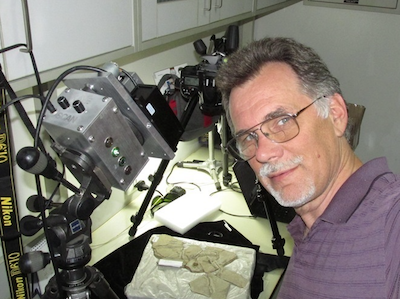Home
A comprehensive resource for safe and responsible laser use
US: Scientist uses "laser-pointer-in-a-can" to discover dinosaur eyes, feathers
In a social media post around late March 2016, Kaye posted photos of a dinosaur’s eye that is only visible with his technique.

A science story notes that Kaye is “maybe the only person on Earth not named Sam Neill who can say he’s looked into the eyes of a pterosaur.”
In previous studies he used green (532 nm), blue (457 nm) and violet (407 nm) laser modules with powers from 150 to 500 milliwatts. This provides much brighter illumination of the subject. For example, a standard 20 watt ultraviolet fluorescent lamp has an irradiance (power over a given area) of 510 milliwatts per square centimeter. A 500 milliwatt (1/2 watt) laser, by comparison, provides an irradiance of around 4000 to 8000 milliwatts per square centimeter.

Kaye with his laser apparatus
The story “What Did Dinosaurs Look Like? Tom Kaye Finds Answers, Feathers With Lasers” appeared online at Inverse.com on April 19 2016. Inverse also featured a previous story, “Lasers Can Tell Us More About Fossils Than Before” on October 8 2015. A May 27 2015 paper by Kaye and associates, written for the online journal PLOS ONE, “Laser-Stimulated Fluorescence in Paleontology”, is here.